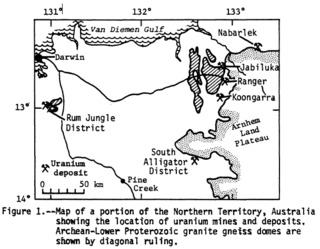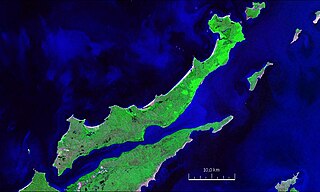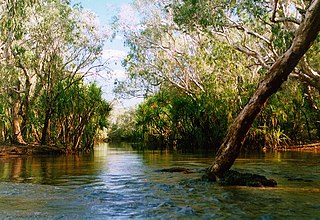Related Research Articles

The Northern Territory is an Australian territory in the central and central northern regions of Australia. It shares borders with Western Australia to the west, South Australia to the south, and Queensland to the east. To the north, the territory looks out to the Timor Sea, the Arafura Sea and the Gulf of Carpentaria, including Western New Guinea and other islands of the Indonesian archipelago.

The Gulf of Carpentaria is a large, shallow sea enclosed on three sides by northern Australia and bounded on the north by the eastern Arafura Sea. The northern boundary is generally defined as a line from Slade Point, Queensland in the northeast, to Cape Arnhem on the Gove Peninsula, Northern Territory in the west.

Arnhem Land is a historical region of the Northern Territory of Australia. It is located in the north-eastern corner of the territory and is around 500 km (310 mi) from the territory capital, Darwin. In 1623, Dutch East India Company captain Willem Joosten van Colster sailed into the Gulf of Carpentaria and Cape Arnhem is named after his ship, the Arnhem, which itself was named after the city of Arnhem in the Netherlands.

In Australia, a station is a large landholding used for producing livestock, predominantly cattle or sheep, that need an extensive range of grazing land. It corresponds to American ranches that operate under the Taylor Grazing Act of 1934 on public lands. The owner of a station is called a pastoralist or a grazier.
A pastoral lease, sometimes called a pastoral run, is an arrangement used in both Australia and New Zealand where government-owned Crown land is leased out to graziers for the purpose of livestock grazing on rangelands.

Alligator Rivers is the name of an area in an Arnhem Land region of the Northern Territory of Australia, containing three rivers, the East, West, and South Alligator Rivers. It is regarded as one of the richest biological regions in Australia, with part of the region in the Kakadu National Park. It is an Important Bird Area (IBA), lying to the east of the Adelaide and Mary River Floodplains IBA. It also contains mineral deposits, especially uranium, and the Ranger Uranium Mine is located there. The area is also rich in Australian Aboriginal art, with 1500 sites. The Kakadu National Park is one of the few World Heritage sites on the list because of both its natural and human heritage values. They were explored by Lieutenant Phillip Parker King in 1820, who named them in the mistaken belief that the crocodiles in the estuaries were alligators.

In Australia and New Zealand, a cattle station is a large farm, the main activity of which is the rearing of cattle. The owner of a cattle station is called a grazier. The largest cattle station in the world is Anna Creek Station in South Australia, which covers an area of 23,677 square kilometres.

The Murchison is an interim Australian bioregion located within the Mid West of Western Australia. The bioregion is loosely related to the catchment area of the Murchison River and comprises 281,200 square kilometres (108,600 sq mi). Traditionally the region is known as The Murchison.

Roper Bar is a location in Australia's Northern Territory. It lies on the traditional land of the Ngalakgan people who used the placename Yurlhbunji to refer to Roper Bar. This part of Australia is extremely remote for travellers although there are a number of Aboriginal communities in the region including Ngukurr, Urapunga and Minyerri. A 4WD trek through these parts can be an extension of the Gulf Track on a journey further up north to Darwin or Arnhem Land.

Elcho Island, known to its traditional owners as Galiwin'ku (Galiwinku) is an island off the coast of Arnhem Land, in the Northern Territory of Australia. It is located at the southern end of the Wessel Islands group located in the East Arnhem Region. Galiwin'ku is also the name of the settlement where the island's largest community lives. Elcho Island formed part of the traditional lands of the Yan-nhaŋu, according to Norman Tindale. According to J. C. Jennison, the Aboriginal inhabitants were the Dhuwal, who called themselves the Kokalango Mala (mala=clan.)

Alpurrurulam, from the original Aboriginal name Ilperrelhelame, also known as Lake Nash, is a locality in the Northern Territory of Australia located in the territory's east about 1,206 kilometres (749 mi) south-east of the territory capital of Darwin and about 570.1 kilometres (354.2 mi) east of the municipal seat of Tennant Creek and about 17 kilometres (11 mi) from the border with the state of Queensland. The town is at the end of the Sandover Highway, which floods each year during the wet season and cuts all road access to the community.

Utopia is an Aboriginal Australian homeland area formed in November 1978 by the amalgamation of the former Utopia pastoral lease with a tract of unalienable land to its north. It covers an area of 3,500 km2 (1,400 sq mi), transected by the Sandover River, and lies on a traditional boundary of the Alyawarre and Anmatyerre people, the two Aboriginal language groups which predominate there today.
The Warumungu are a group of Indigenous Australians of the Northern Territory. Modern day Warumungu are mainly concentrated in the region of Tennant Creek and Alice Springs.

Elsey Station is a pastoral lease that once operated as a cattle station in the Northern Territory.
Joseph Bradshaw was a pastoralist in Western Australia and then the Northern Territory.

The Goyder River is a river in the Northern Territory, Australia.
The Warndarang (waɳʈaraŋ) were a predominantly coastal Aboriginal Australian people of eastern Northern Territory. Though extinct as a distinct ethnolinguistic group, their descendants survive among the neighbouring Nunggubuyu.
The Ritharrngu and also known as the Diakui, are an Aboriginal Australian people of Arnhem Land in the Northern Territory, of the Yolngu group of peoples. Their clans are Wagilak and Manggura, and Ritharngu.
The Mangarayi, also written Mangarai, were an indigenous Australian people of the Northern Territory.

Argadargada Station is a pastoral lease that operates as a cattle station in the Northern Territory of Australia.
References
- 1 2 3 4 Roberts, Tony; Roberts, Tony (Anthony John), 1945- (2005), Frontier justice : a history of the Gulf country to 1900, University of Queensland Press, ISBN 978-0-7022-3361-6 CS1 maint: multiple names: authors list (link)
- 1 2 "PRODUCE NOTES". The Register (Adelaide) . LXVIII, (17, 573). South Australia. 11 March 1903. p. 8. Retrieved 19 October 2020– via National Library of Australia.CS1 maint: extra punctuation (link)
- ↑ Bauer, F. H. (Francis Harry), 1918-1998; CSIRO. Division of Land Research and Regional Survey (1959), "Historical geographic survey of part of Northern Australia. Part 1,Introduction and the eastern gulf region / by F.H. Bauer", Divisional report (CSIRO. Division of Land Research and Regional Survey), C.S.I.R.O, retrieved 19 October 2020CS1 maint: multiple names: authors list (link)
- ↑ Bauer, F. H. (Francis Harry); CSIRO. Division of Land Research and Regional Survey (1964), Historical geography of white settlement in part of Northern Australia. Part 2. The Katherine-Darwin Region, C.S.I.R.O, retrieved 19 October 2020